warning light FORD EXCURSION 2003 1.G User Guide
[x] Cancel search | Manufacturer: FORD, Model Year: 2003, Model line: EXCURSION, Model: FORD EXCURSION 2003 1.GPages: 240, PDF Size: 2.2 MB
Page 108 of 240
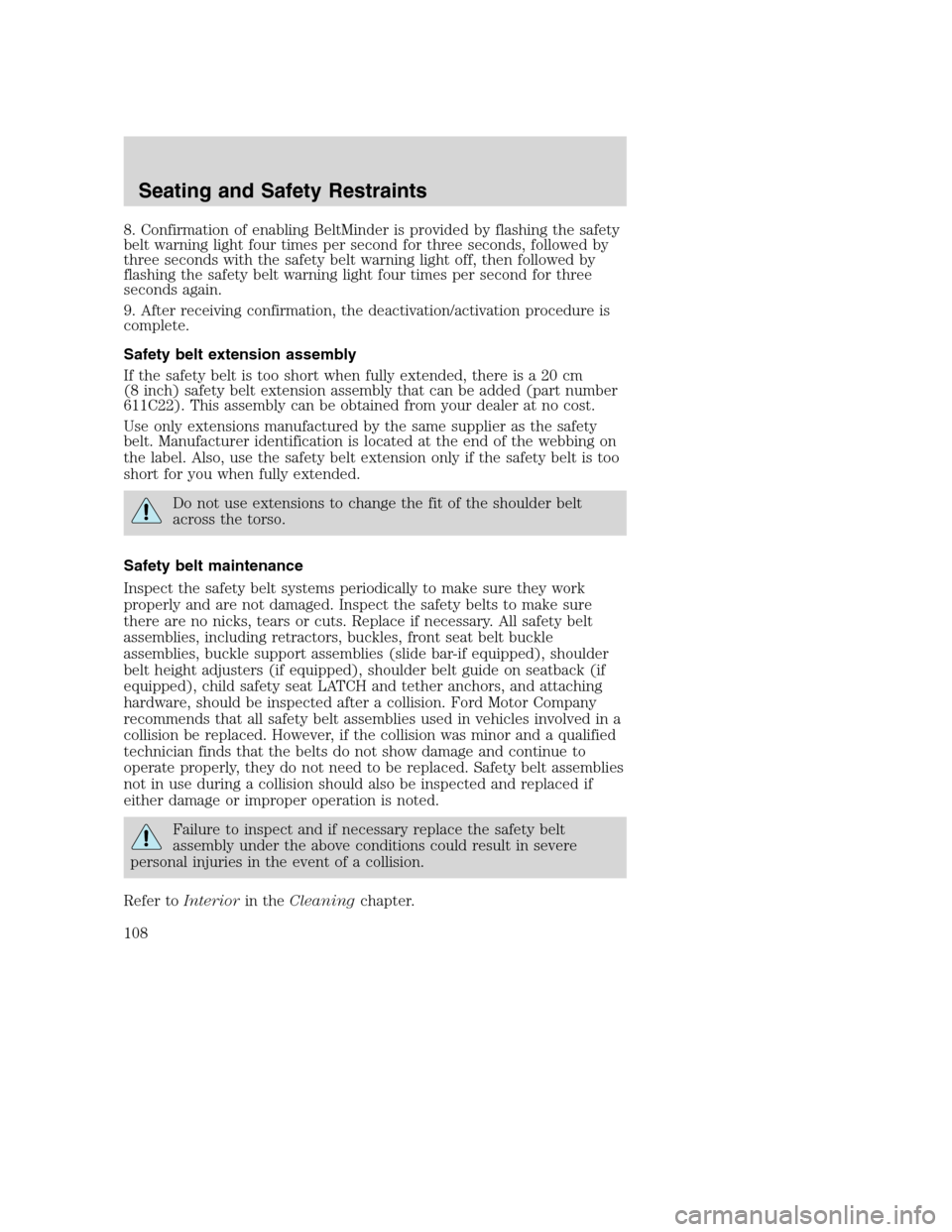
8. Confirmation of enabling BeltMinder is provided by flashing the safety
belt warning light four times per second for three seconds, followed by
three seconds with the safety belt warning light off, then followed by
flashing the safety belt warning light four times per second for three
seconds again.
9. After receiving confirmation, the deactivation/activation procedure is
complete.
Safety belt extension assembly
If the safety belt is too short when fully extended, there is a 20 cm
(8 inch) safety belt extension assembly that can be added (part number
611C22). This assembly can be obtained from your dealer at no cost.
Use only extensions manufactured by the same supplier as the safety
belt. Manufacturer identification is located at the end of the webbing on
the label. Also, use the safety belt extension only if the safety belt is too
short for you when fully extended.
Do not use extensions to change the fit of the shoulder belt
across the torso.
Safety belt maintenance
Inspect the safety belt systems periodically to make sure they work
properly and are not damaged. Inspect the safety belts to make sure
there are no nicks, tears or cuts. Replace if necessary. All safety belt
assemblies, including retractors, buckles, front seat belt buckle
assemblies, buckle support assemblies (slide bar-if equipped), shoulder
belt height adjusters (if equipped), shoulder belt guide on seatback (if
equipped), child safety seat LATCH and tether anchors, and attaching
hardware, should be inspected after a collision. Ford Motor Company
recommends that all safety belt assemblies used in vehicles involved in a
collision be replaced. However, if the collision was minor and a qualified
technician finds that the belts do not show damage and continue to
operate properly, they do not need to be replaced. Safety belt assemblies
not in use during a collision should also be inspected and replaced if
either damage or improper operation is noted.
Failure to inspect and if necessary replace the safety belt
assembly under the above conditions could result in severe
personal injuries in the event of a collision.
Refer toInteriorin theCleaningchapter.
Seating and Safety Restraints
108
Page 112 of 240
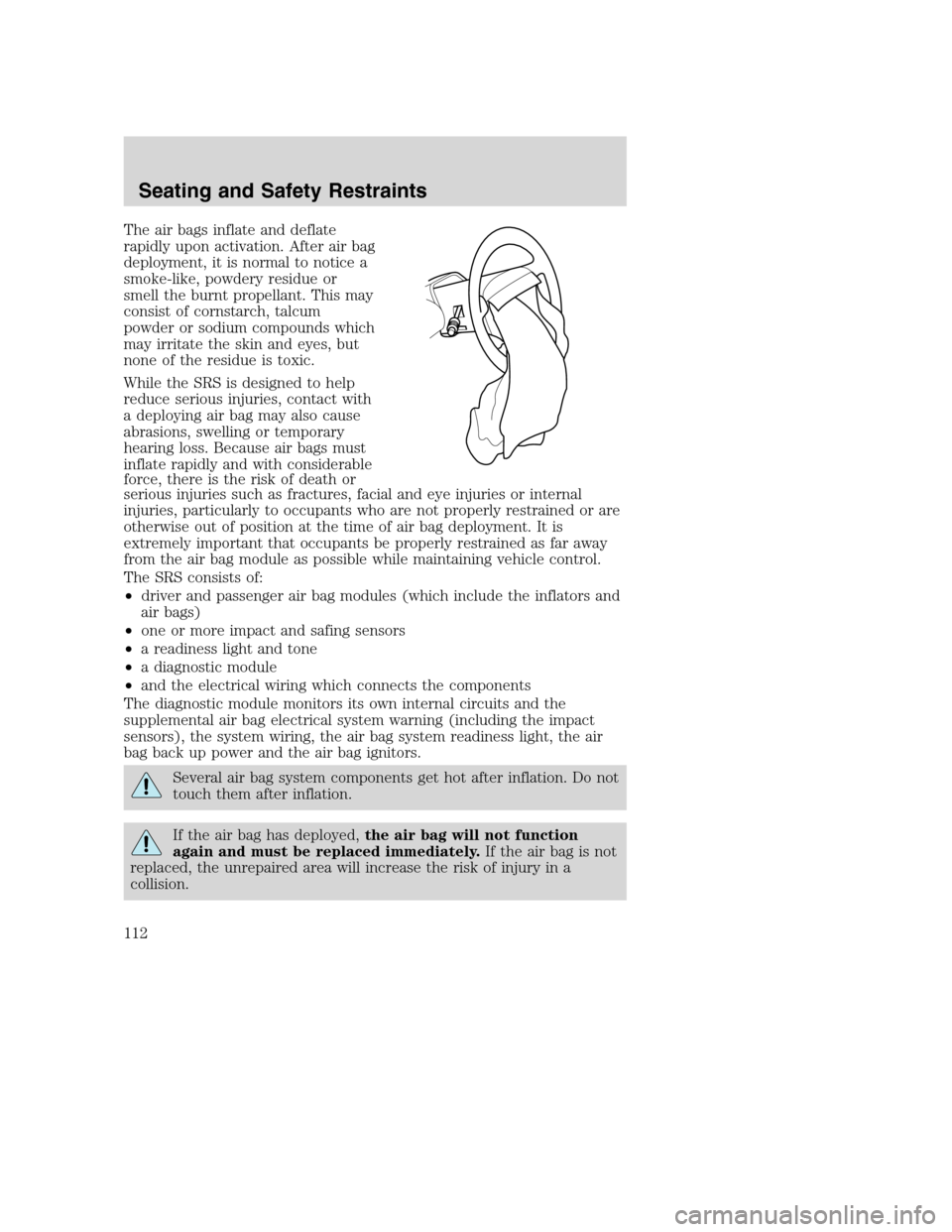
The air bags inflate and deflate
rapidly upon activation. After air bag
deployment, it is normal to notice a
smoke-like, powdery residue or
smell the burnt propellant. This may
consist of cornstarch, talcum
powder or sodium compounds which
may irritate the skin and eyes, but
none of the residue is toxic.
While the SRS is designed to help
reduce serious injuries, contact with
a deploying air bag may also cause
abrasions, swelling or temporary
hearing loss. Because air bags must
inflate rapidly and with considerable
force, there is the risk of death or
serious injuries such as fractures, facial and eye injuries or internal
injuries, particularly to occupants who are not properly restrained or are
otherwise out of position at the time of air bag deployment. It is
extremely important that occupants be properly restrained as far away
from the air bag module as possible while maintaining vehicle control.
The SRS consists of:
•driver and passenger air bag modules (which include the inflators and
air bags)
•one or more impact and safing sensors
•a readiness light and tone
•a diagnostic module
•and the electrical wiring which connects the components
The diagnostic module monitors its own internal circuits and the
supplemental air bag electrical system warning (including the impact
sensors), the system wiring, the air bag system readiness light, the air
bag back up power and the air bag ignitors.
Several air bag system components get hot after inflation. Do not
touch them after inflation.
If the air bag has deployed,the air bag will not function
again and must be replaced immediately.If the air bag is not
replaced, the unrepaired area will increase the risk of injury in a
collision.
Seating and Safety Restraints
112
Page 124 of 240
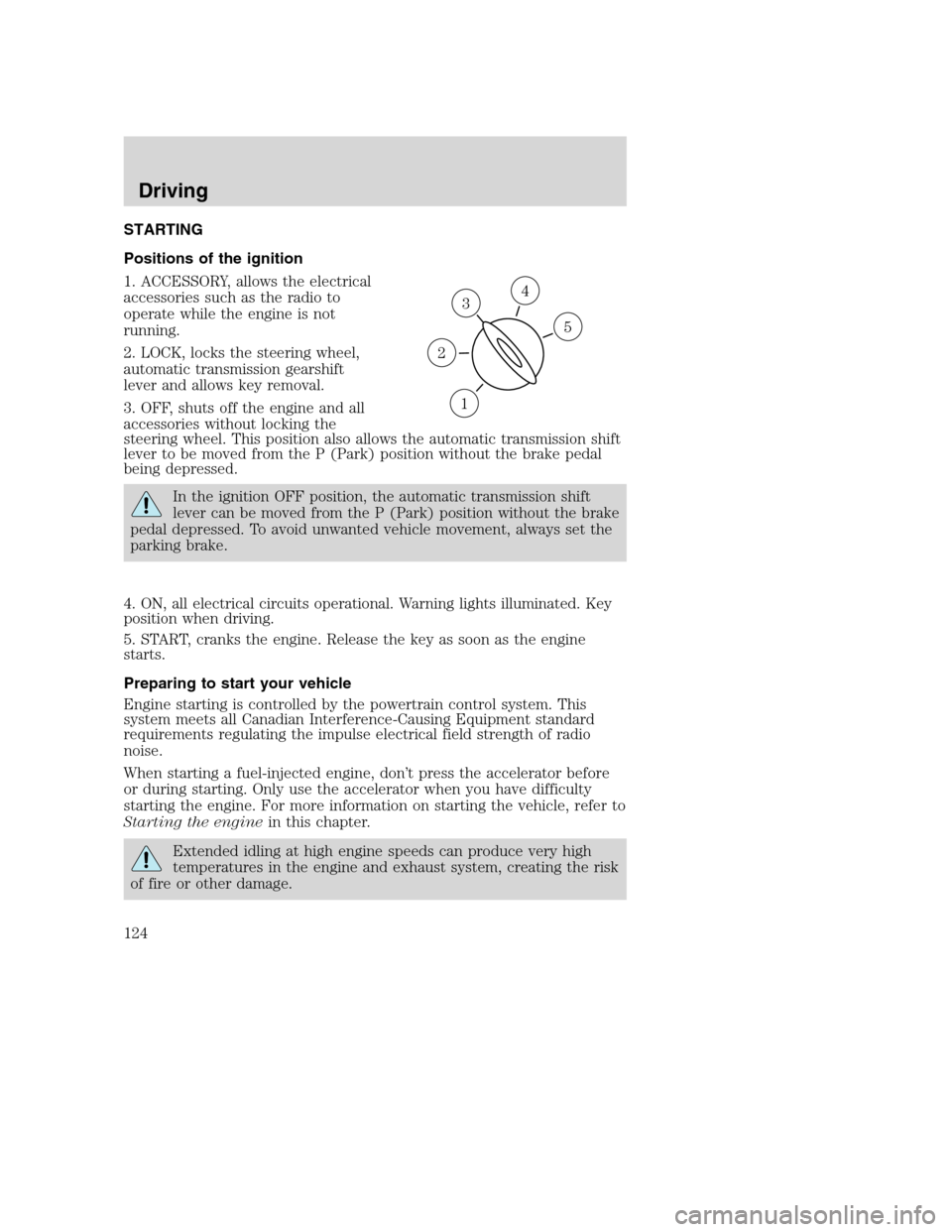
STARTING
Positions of the ignition
1. ACCESSORY, allows the electrical
accessories such as the radio to
operate while the engine is not
running.
2. LOCK, locks the steering wheel,
automatic transmission gearshift
lever and allows key removal.
3. OFF, shuts off the engine and all
accessories without locking the
steering wheel. This position also allows the automatic transmission shift
lever to be moved from the P (Park) position without the brake pedal
being depressed.
In the ignition OFF position, the automatic transmission shift
lever can be moved from the P (Park) position without the brake
pedal depressed. To avoid unwanted vehicle movement, always set the
parking brake.
4. ON, all electrical circuits operational. Warning lights illuminated. Key
position when driving.
5. START, cranks the engine. Release the key as soon as the engine
starts.
Preparing to start your vehicle
Engine starting is controlled by the powertrain control system. This
system meets all Canadian Interference-Causing Equipment standard
requirements regulating the impulse electrical field strength of radio
noise.
When starting a fuel-injected engine, don’t press the accelerator before
or during starting. Only use the accelerator when you have difficulty
starting the engine. For more information on starting the vehicle, refer to
Starting the enginein this chapter.
Extended idling at high engine speeds can produce very high
temperatures in the engine and exhaust system, creating the risk
of fire or other damage.
3
1
2
5
4
Driving
124
Page 128 of 240
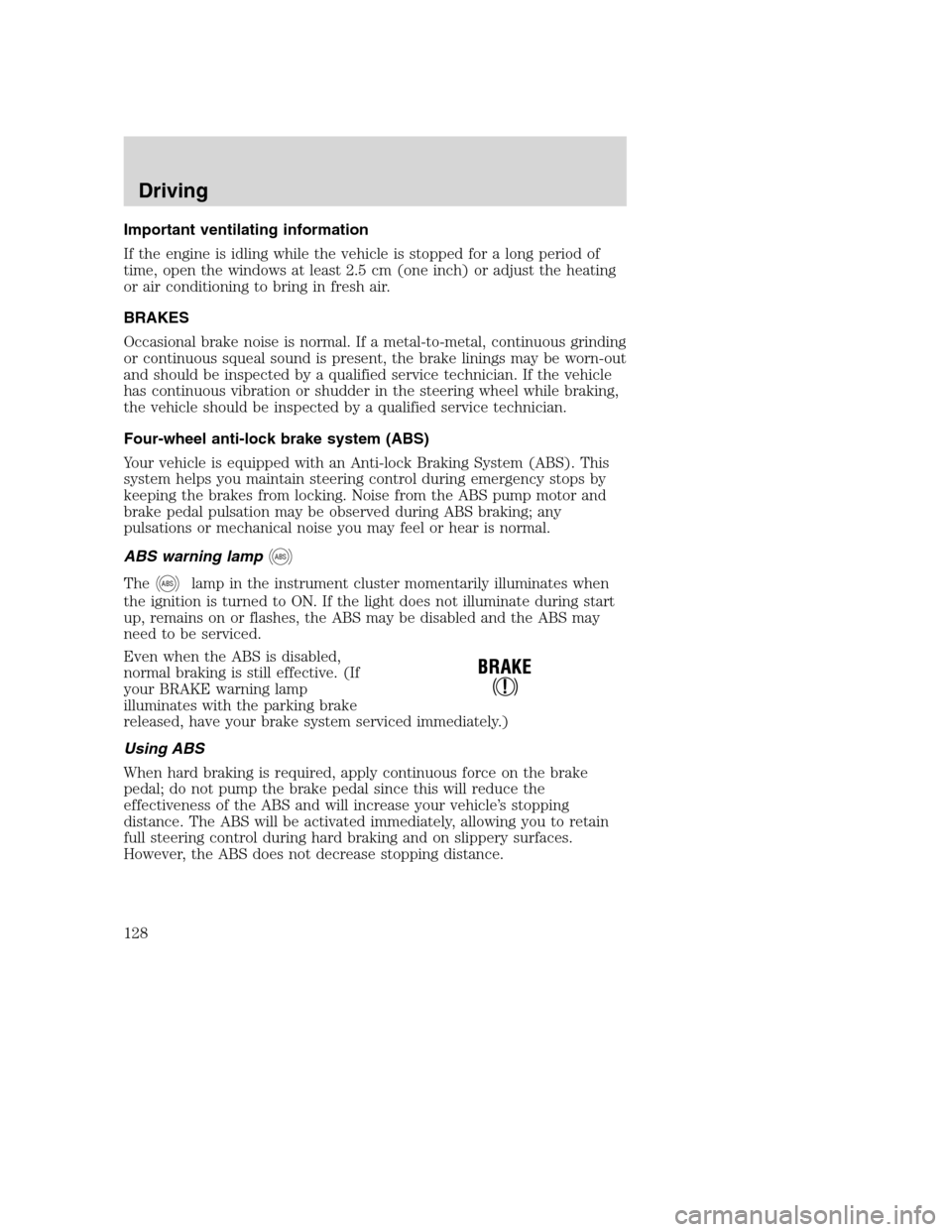
Important ventilating information
If the engine is idling while the vehicle is stopped for a long period of
time, open the windows at least 2.5 cm (one inch) or adjust the heating
or air conditioning to bring in fresh air.
BRAKES
Occasional brake noise is normal. If a metal-to-metal, continuous grinding
or continuous squeal sound is present, the brake linings may be worn-out
and should be inspected by a qualified service technician. If the vehicle
has continuous vibration or shudder in the steering wheel while braking,
the vehicle should be inspected by a qualified service technician.
Four-wheel anti-lock brake system (ABS)
Your vehicle is equipped with an Anti-lock Braking System (ABS). This
system helps you maintain steering control during emergency stops by
keeping the brakes from locking. Noise from the ABS pump motor and
brake pedal pulsation may be observed during ABS braking; any
pulsations or mechanical noise you may feel or hear is normal.
ABS warning lamp
ABS
TheABSlamp in the instrument cluster momentarily illuminates when
the ignition is turned to ON. If the light does not illuminate during start
up, remains on or flashes, the ABS may be disabled and the ABS may
need to be serviced.
Even when the ABS is disabled,
normal braking is still effective. (If
your BRAKE warning lamp
illuminates with the parking brake
released, have your brake system serviced immediately.)
Using ABS
When hard braking is required, apply continuous force on the brake
pedal; do not pump the brake pedal since this will reduce the
effectiveness of the ABS and will increase your vehicle’s stopping
distance. The ABS will be activated immediately, allowing you to retain
full steering control during hard braking and on slippery surfaces.
However, the ABS does not decrease stopping distance.
Driving
128
Page 140 of 240
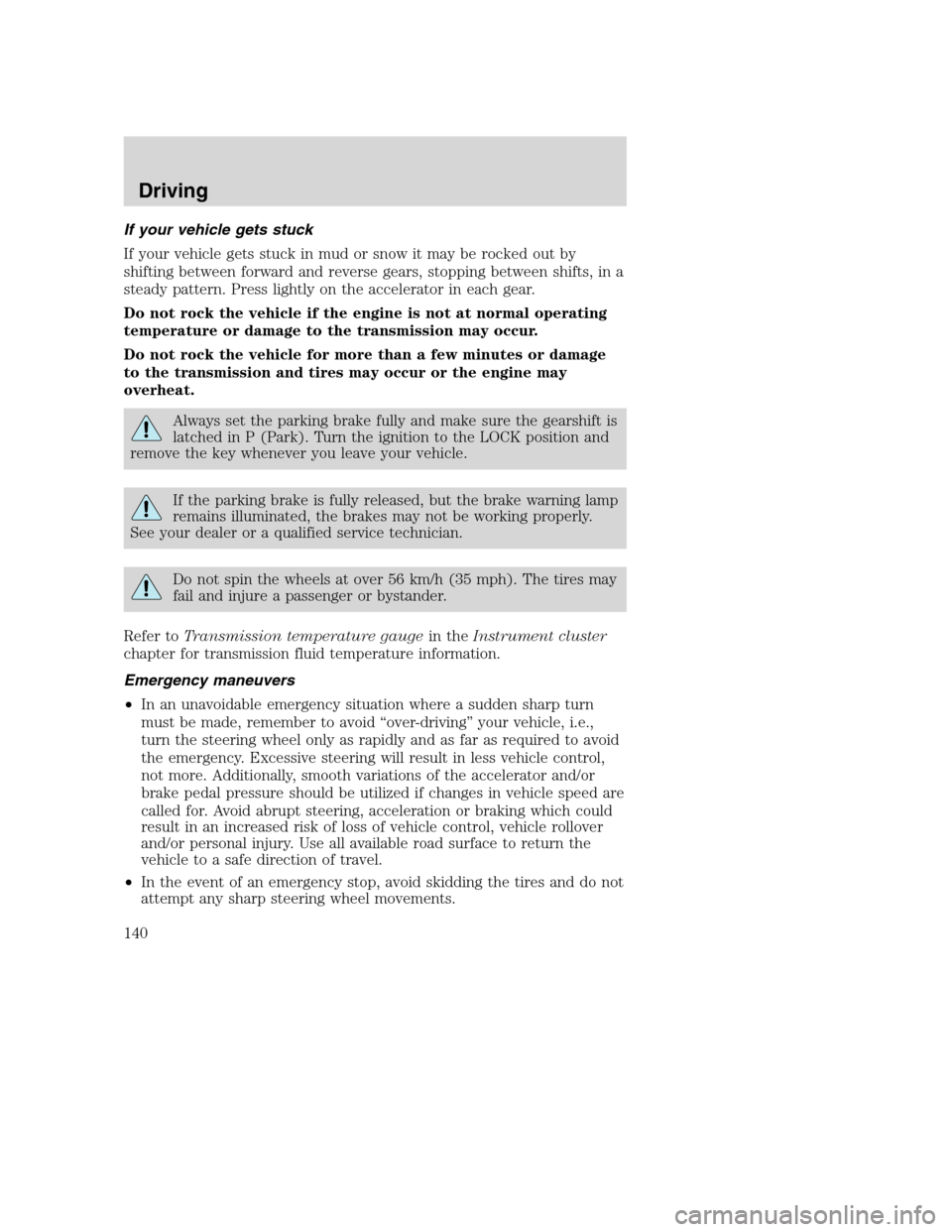
If your vehicle gets stuck
If your vehicle gets stuck in mud or snow it may be rocked out by
shifting between forward and reverse gears, stopping between shifts, in a
steady pattern. Press lightly on the accelerator in each gear.
Do not rock the vehicle if the engine is not at normal operating
temperature or damage to the transmission may occur.
Do not rock the vehicle for more than a few minutes or damage
to the transmission and tires may occur or the engine may
overheat.
Always set the parking brake fully and make sure the gearshift is
latched in P (Park). Turn the ignition to the LOCK position and
remove the key whenever you leave your vehicle.
If the parking brake is fully released, but the brake warning lamp
remains illuminated, the brakes may not be working properly.
See your dealer or a qualified service technician.
Do not spin the wheels at over 56 km/h (35 mph). The tires may
fail and injure a passenger or bystander.
Refer toTransmission temperature gaugein theInstrument cluster
chapter for transmission fluid temperature information.
Emergency maneuvers
•In an unavoidable emergency situation where a sudden sharp turn
must be made, remember to avoid “over-driving” your vehicle, i.e.,
turn the steering wheel only as rapidly and as far as required to avoid
the emergency. Excessive steering will result in less vehicle control,
not more. Additionally, smooth variations of the accelerator and/or
brake pedal pressure should be utilized if changes in vehicle speed are
called for. Avoid abrupt steering, acceleration or braking which could
result in an increased risk of loss of vehicle control, vehicle rollover
and/or personal injury. Use all available road surface to return the
vehicle to a safe direction of travel.
•In the event of an emergency stop, avoid skidding the tires and do not
attempt any sharp steering wheel movements.
Driving
140
Page 211 of 240
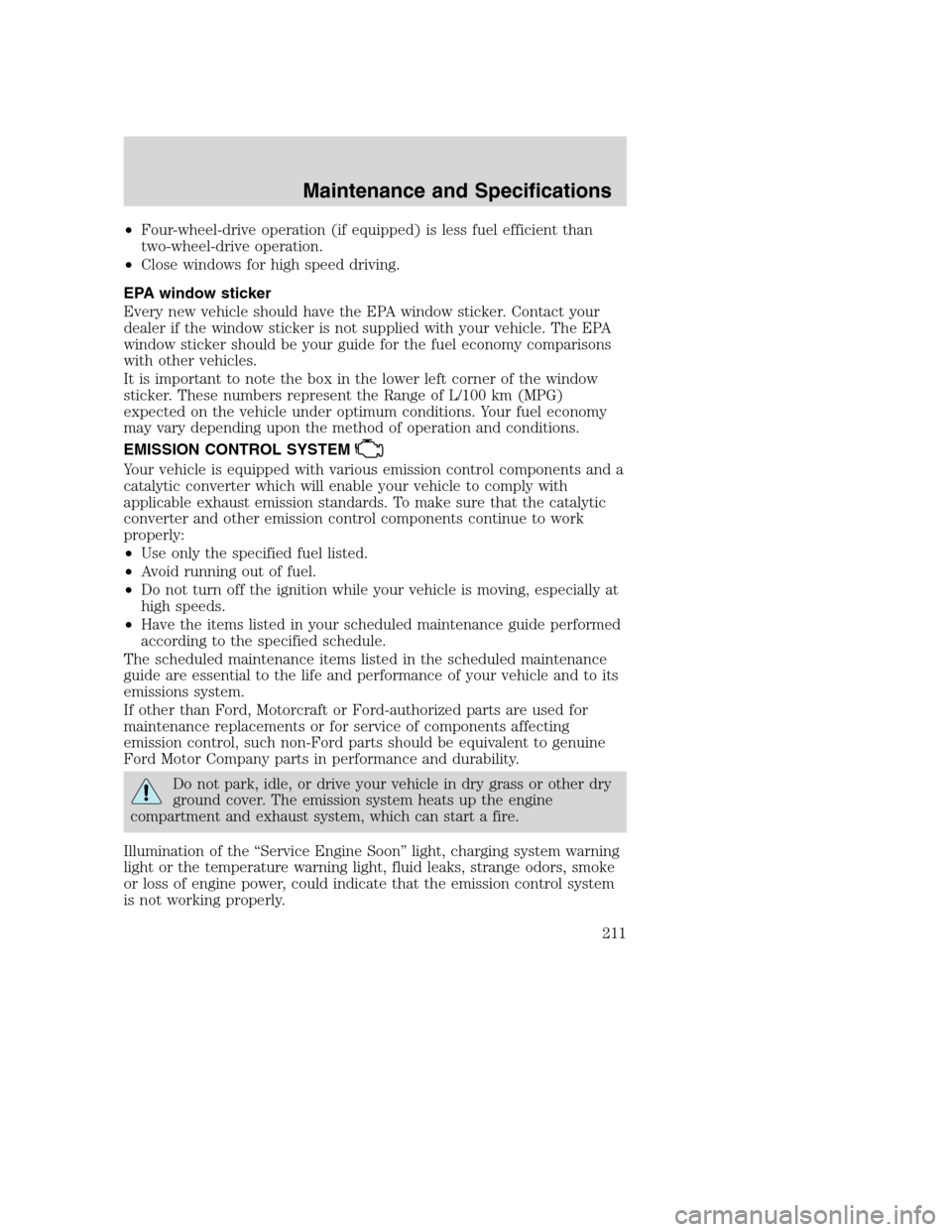
•Four-wheel-drive operation (if equipped) is less fuel efficient than
two-wheel-drive operation.
•Close windows for high speed driving.
EPA window sticker
Every new vehicle should have the EPA window sticker. Contact your
dealer if the window sticker is not supplied with your vehicle. The EPA
window sticker should be your guide for the fuel economy comparisons
with other vehicles.
It is important to note the box in the lower left corner of the window
sticker. These numbers represent the Range of L/100 km (MPG)
expected on the vehicle under optimum conditions. Your fuel economy
may vary depending upon the method of operation and conditions.
EMISSION CONTROL SYSTEM
Your vehicle is equipped with various emission control components and a
catalytic converter which will enable your vehicle to comply with
applicable exhaust emission standards. To make sure that the catalytic
converter and other emission control components continue to work
properly:
•Use only the specified fuel listed.
•Avoid running out of fuel.
•Do not turn off the ignition while your vehicle is moving, especially at
high speeds.
•Have the items listed in your scheduled maintenance guide performed
according to the specified schedule.
The scheduled maintenance items listed in the scheduled maintenance
guide are essential to the life and performance of your vehicle and to its
emissions system.
If other than Ford, Motorcraft or Ford-authorized parts are used for
maintenance replacements or for service of components affecting
emission control, such non-Ford parts should be equivalent to genuine
Ford Motor Company parts in performance and durability.
Do not park, idle, or drive your vehicle in dry grass or other dry
ground cover. The emission system heats up the engine
compartment and exhaust system, which can start a fire.
Illumination of the “Service Engine Soon” light, charging system warning
light or the temperature warning light, fluid leaks, strange odors, smoke
or loss of engine power, could indicate that the emission control system
is not working properly.
Maintenance and Specifications
211
Page 212 of 240

Exhaust leaks may result in entry of harmful and potentially
lethal fumes into the passenger compartment.
Do not make any unauthorized changes to your vehicle or engine. By
law, vehicle owners and anyone who manufactures, repairs, services,
sells, leases, trades vehicles, or supervises a fleet of vehicles are not
permitted to intentionally remove an emission control device or prevent
it from working. Information about your vehicle’s emission system is on
the Vehicle Emission Control Information Decal located on or near the
engine. This decal identifies engine displacement and gives some tune up
specifications.
Please consult yourWarranty Guidefor complete emission warranty
information.
Readiness for Inspection/Maintenance (I/M) testing
In some localities, it may be a legal requirement to pass an I/M test of
the on-board diagnostics system. If your “Check Engine/Service Engine
Soon” light is on, refer to the description in theWarning lights and
chimessection of theInstrument clusterchapter. Your vehicle may not
pass the I/M test with the “Check Engine/Service Engine Soon” light on.
If the vehicle’s powertrain system or its battery has just been serviced,
the on-board diagnostics system is reset to a “not ready for I/M test”
condition. To ready the on-board diagnostics system for I/M testing, a
minimum of 30 minutes of city and highway driving is necessary as
described below:
•First, at least 10 minutes of driving on an expressway or highway.
•Next, at least 20 minutes driving in stop-and-go, city-type traffic with
at least four idle periods.
Allow the vehicle to sit for at least eight hours without starting the
engine. Then, start the engine and complete the above driving cycle. The
engine must warm up to its normal operating temperature. Once started,
do not turn off the engine until the above driving cycle is complete.
Maintenance and Specifications
212
Page 235 of 240
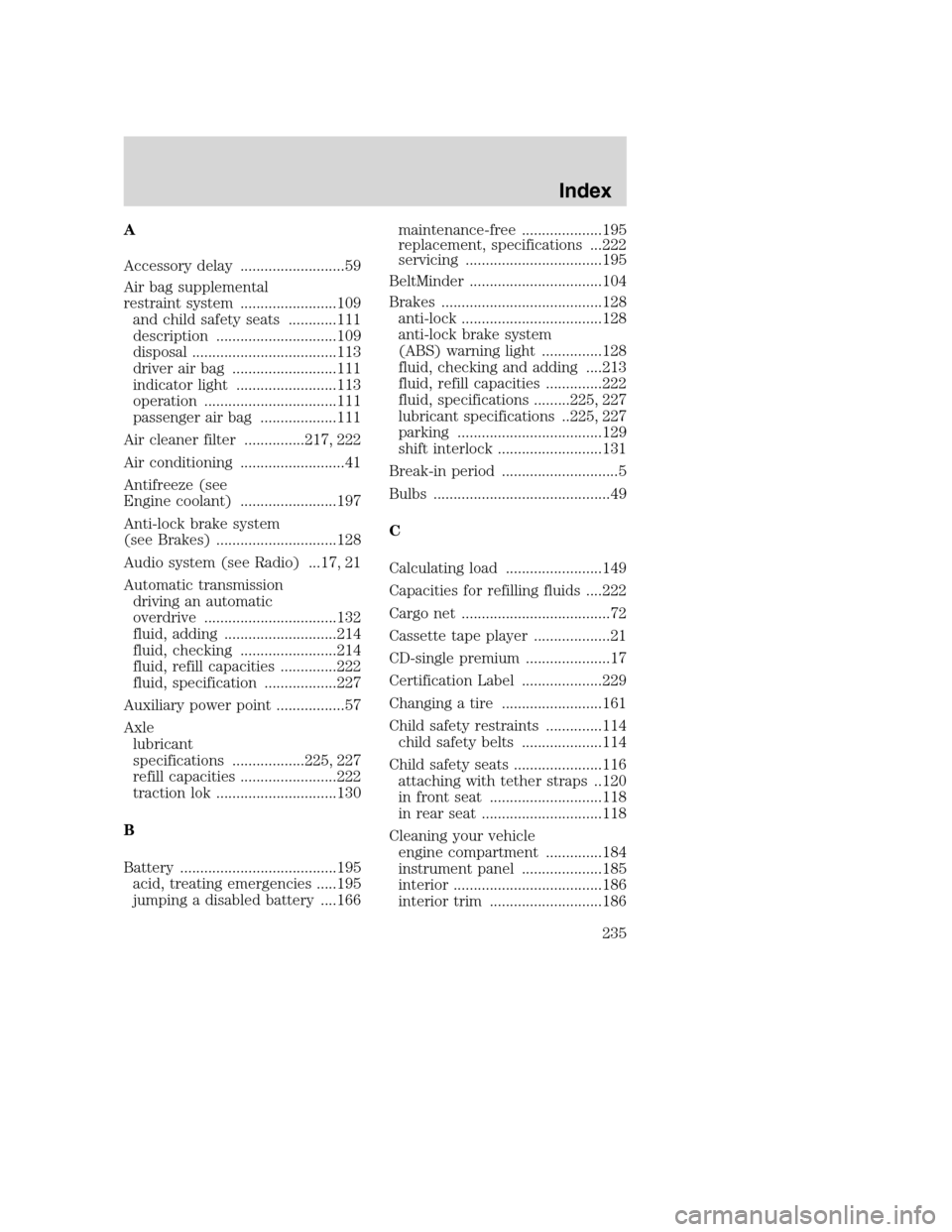
A
Accessory delay ..........................59
Air bag supplemental
restraint system ........................109
and child safety seats ............111
description ..............................109
disposal ....................................113
driver air bag ..........................111
indicator light .........................113
operation .................................111
passenger air bag ...................111
Air cleaner filter ...............217, 222
Air conditioning ..........................41
Antifreeze (see
Engine coolant) ........................197
Anti-lock brake system
(see Brakes) ..............................128
Audio system (see Radio) ...17, 21
Automatic transmission
driving an automatic
overdrive .................................132
fluid, adding ............................214
fluid, checking ........................214
fluid, refill capacities ..............222
fluid, specification ..................227
Auxiliary power point .................57
Axle
lubricant
specifications ..................225, 227
refill capacities ........................222
traction lok ..............................130
B
Battery .......................................195
acid, treating emergencies .....195
jumping a disabled battery ....166maintenance-free ....................195
replacement, specifications ...222
servicing ..................................195
BeltMinder .................................104
Brakes ........................................128
anti-lock ...................................128
anti-lock brake system
(ABS) warning light ...............128
fluid, checking and adding ....213
fluid, refill capacities ..............222
fluid, specifications .........225, 227
lubricant specifications ..225, 227
parking ....................................129
shift interlock ..........................131
Break-in period .............................5
Bulbs ............................................49
C
Calculating load ........................149
Capacities for refilling fluids ....222
Cargo net .....................................72
Cassette tape player ...................21
CD-single premium .....................17
Certification Label ....................229
Changing a tire .........................161
Child safety restraints ..............114
child safety belts ....................114
Child safety seats ......................116
attaching with tether straps ..120
in front seat ............................118
in rear seat ..............................118
Cleaning your vehicle
engine compartment ..............184
instrument panel ....................185
interior .....................................186
interior trim ............................186
Index
235
Page 238 of 240
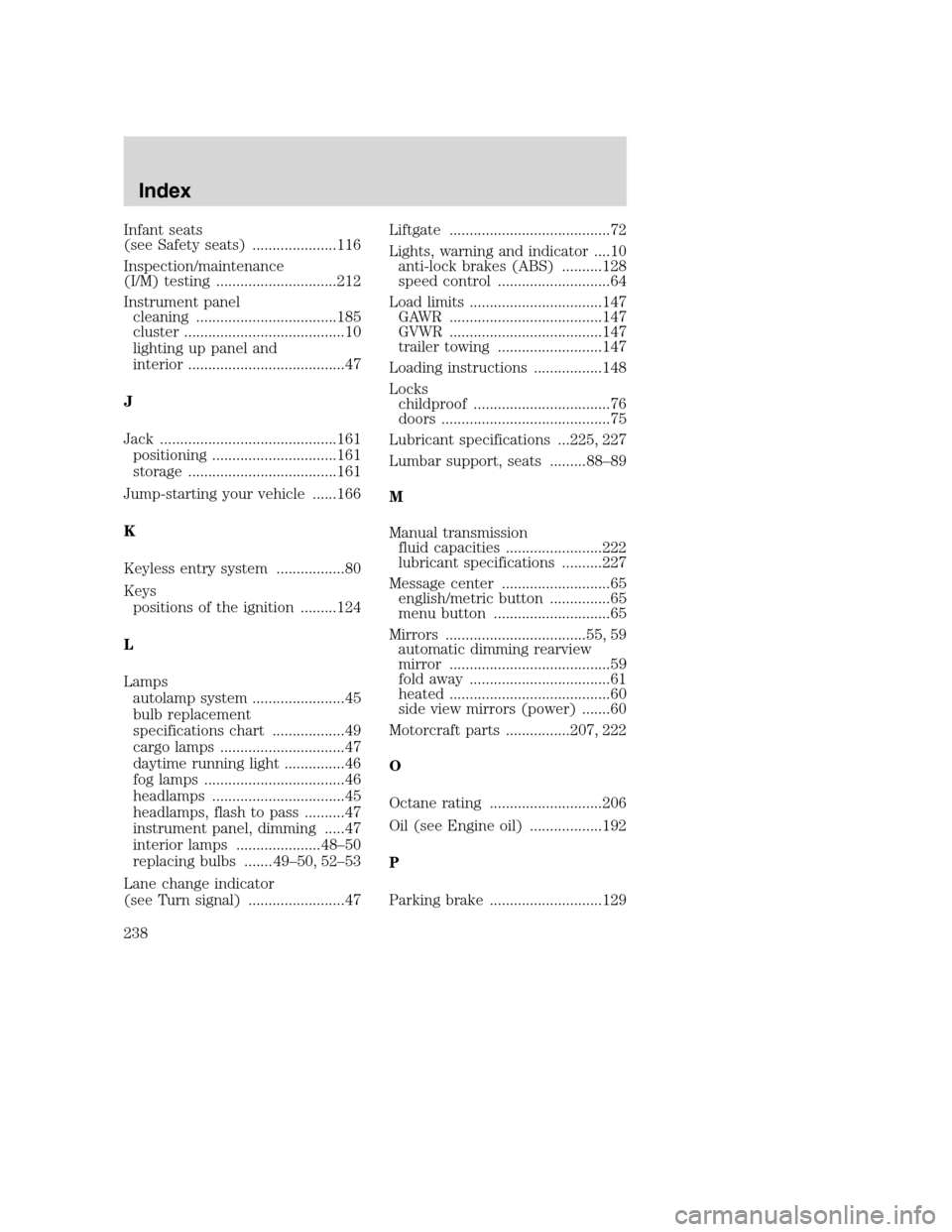
Infant seats
(see Safety seats) .....................116
Inspection/maintenance
(I/M) testing ..............................212
Instrument panel
cleaning ...................................185
cluster ........................................10
lighting up panel and
interior .......................................47
J
Jack ............................................161
positioning ...............................161
storage .....................................161
Jump-starting your vehicle ......166
K
Keyless entry system .................80
Keys
positions of the ignition .........124
L
Lamps
autolamp system .......................45
bulb replacement
specifications chart ..................49
cargo lamps ...............................47
daytime running light ...............46
fog lamps ...................................46
headlamps .................................45
headlamps, flash to pass ..........47
instrument panel, dimming .....47
interior lamps .....................48–50
replacing bulbs ....... 49–50, 52–53
Lane change indicator
(see Turn signal) ........................47Liftgate ........................................72
Lights, warning and indicator ....10
anti-lock brakes (ABS) ..........128
speed control ............................64
Load limits .................................147
GAWR ......................................147
GVWR ......................................147
trailer towing ..........................147
Loading instructions .................148
Locks
childproof ..................................76
doors ..........................................75
Lubricant specifications ...225, 227
Lumbar support, seats .........88–89
M
Manual transmission
fluid capacities ........................222
lubricant specifications ..........227
Message center ...........................65
english/metric button ...............65
menu button .............................65
Mirrors ...................................55, 59
automatic dimming rearview
mirror ........................................59
fold away ...................................61
heated ........................................60
side view mirrors (power) .......60
Motorcraft parts ................207, 222
O
Octane rating ............................206
Oil (see Engine oil) ..................192
P
Parking brake ............................129
Index
238
Page 239 of 240
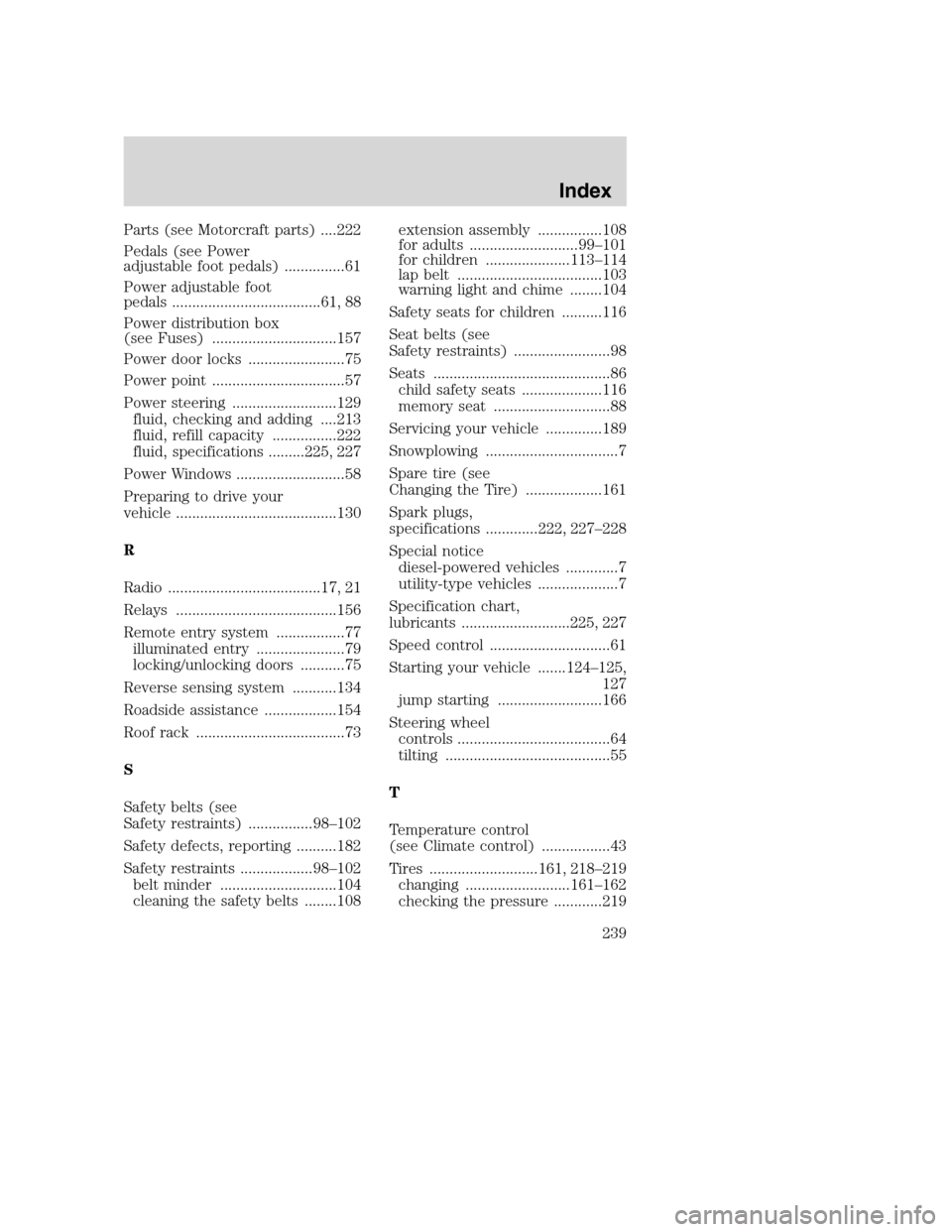
Parts (see Motorcraft parts) ....222
Pedals (see Power
adjustable foot pedals) ...............61
Power adjustable foot
pedals .....................................61, 88
Power distribution box
(see Fuses) ...............................157
Power door locks ........................75
Power point .................................57
Power steering ..........................129
fluid, checking and adding ....213
fluid, refill capacity ................222
fluid, specifications .........225, 227
Power Windows ...........................58
Preparing to drive your
vehicle ........................................130
R
Radio ......................................17, 21
Relays ........................................156
Remote entry system .................77
illuminated entry ......................79
locking/unlocking doors ...........75
Reverse sensing system ...........134
Roadside assistance ..................154
Roof rack .....................................73
S
Safety belts (see
Safety restraints) ................98–102
Safety defects, reporting ..........182
Safety restraints ..................98–102
belt minder .............................104
cleaning the safety belts ........108extension assembly ................108
for adults ...........................99–101
for children .....................113–114
lap belt ....................................103
warning light and chime ........104
Safety seats for children ..........116
Seat belts (see
Safety restraints) ........................98
Seats ............................................86
child safety seats ....................116
memory seat .............................88
Servicing your vehicle ..............189
Snowplowing .................................7
Spare tire (see
Changing the Tire) ...................161
Spark plugs,
specifications .............222, 227–228
Special notice
diesel-powered vehicles .............7
utility-type vehicles ....................7
Specification chart,
lubricants ...........................225, 227
Speed control ..............................61
Starting your vehicle .......124–125,
127
jump starting ..........................166
Steering wheel
controls ......................................64
tilting .........................................55
T
Temperature control
(see Climate control) .................43
Tires ...........................161, 218–219
changing ..........................161–162
checking the pressure ............219
Index
239